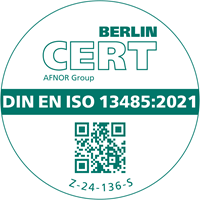To gain a picture of the success of the new training concept Otis – the virtual patient in practice, impressions were collected from various users. Course leaders, doctors, hearing aid audiologists, audiometrists and students talk about their experiences:
“The most difficult thing in audiometry work is having a proper idea of acoustic processes in the human head. How does cross-hearing occur? What are the consequences of this process in audiometry? In my experience, it takes months of studying the literature and working exclusively with real subjects to acquire a routine which also makes it possible to deal with problematic cases. Practising with a simulator can simplify and shorten this process to an appreciable degree.”
„Der Erwerb von praktischen Kompetenzen im Fach Audiologie und Audiometrie ist ein zentrales Element in der Ausbildung zukünftiger LogopädInnen. Im Transfer zu digitalen Lernszenenarien ist Otis dabei die ideale Unterstützung und begleitet diesen Kompetenzerwerb optimal. Studierende profitieren von selbstregulierten Praxiserfahrungen, realitätsnahen Lernumgebungen und individuellen Feedbackmöglichkeiten durch uns Lehrende.”
“I am impressed by the technical perfection of Otis – the virtual patient, and its authentic case examples are in line with the trend towards problem-based teaching in the study of medicine…”
“Otis – the virtual patient can offer the student/trainee hands-on computer-based training in air conduction, bone conduction, and masking test exercises. Otis – the virtual patient would be an excellent compliment to the student experience that includes appropriate testing of live clients. Exercises can be submitted online for evaluation by a mentor for evaluations of time and accuracy. Additional modules ask for short answer test reports. This training program is well designed and would be beneficial for most any beginning-level student in the hearing healthcare field.”
“Otis is a very efficient, fast and easy application to use. Students adapt to it very easily and almost without any difficulties.
The GUI is very user friendly and the workflow is smooth and well organized.
The fact that the head cross difference (HCD) can be manipulated is very important for students, and it makes it easier for them to understand the masking subject.”
“We have used Otis for more than a decade in our short courses, undergraduate and postgraduate programmes. We have found the flexibility, including availability of student licenses, and comprehensive exercises to be very important to the development of our students’ understanding and skills related to their learning objectives.”
“We installed Otis – the virtual patient into our lab computers for use by students in the Doctor of Audiology program at Nova Southeastern University. It is an excellent tool to assist students to learn hearing evaluation techniques. The Otis – the virtual patient assists students who are learning the concepts of masking, increasing their evaluation speed, and integrating diagnostic information for patient management. With Otis – the virtual patient, students are able to practice what they are learning in the classroom and apply these techniques to the clinic. I highly recommend this system for student training.”
“Our students commented how much they like to work with Otis – the virtual patient, and appreciate in particular the instantaneous feedback. This follows best practice for learning by doing, and is of immense benefit. … This has resulted in good student engagement and a much higher learning outcome with better grades for the skills lab modules both for our first and second year students.”
“It ‘grabbed’ me immediately, because I really wanted to go on and do more exercises and send them to you. Communication (correction and answers) with the “tutors” is speedy and straightforward. The software is easy for anyone to understand, and in addition it’s humorous.”
“A surgical otologist relies on reliable pre-operative audiometric measurements and especially on correct post-operative audiometry. As these are subjective measurements, they depend on the patient’s co-operation and the audiologist’s experience. Thanks to the audiometry training program, the competence and continuing professional training of every audiologist can be improved, thus assuring optimum audiometric quality.”
“Our students have found Otis – the virtual patient to be very useful in attaining the technical skills for testing. The case bank is particularly helpful in preparing students for a variety of hearing loss configurations prior to their first clinical encounters with clients.”

Prof. Annette Limberger
Aalen UniversityAalen, Germany
“Audiometry is a matter of practice. Correct results can only be achieved with a great deal of practice and a feeling for the activity – and so beginners need a lot of training. That is what Otis – the virtual patient provides and a book doesn’t…”

Herbert Jakits
Chartered audiologistZurich, Switzerland
“The obvious benefits are that we can now make use of slack time to practice with Otis – the virtual patient, and that staff can manage their own training whenever it is convenient or an opportunity presents itself…”





















